
The Geheime Staatspolizei, abbreviated Gestapo, was the official secret police of Nazi Germany and in German-occupied Europe.
Führer is a German word meaning "leader" or "guide". As a political title, it is strongly associated with Adolf Hitler, the dictator of Nazi Germany from 1933 to 1945. Hitler officially styled himself der Führer und Reichskanzler after the death of President Paul von Hindenburg in 1934 and the subsequent merging of the offices of Reichspräsident and Reichskanzler.
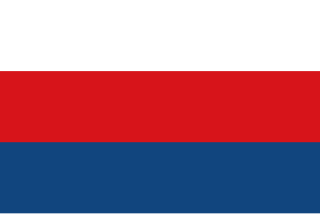
The Protectorate of Bohemia and Moravia was a partially-annexed territory of Nazi Germany that was established on 16 March 1939 after the German occupation of the Czech lands. The protectorate's population was mostly ethnic Czech.

The Hitler cabinet was the government of Nazi Germany between 30 January 1933 and 30 April 1945 upon the appointment of Adolf Hitler as Chancellor of the German Reich by President Paul von Hindenburg. It was contrived by the national conservative politician Franz von Papen, who reserved the office of the Vice-Chancellor for himself. Originally, Hitler's first cabinet was called the Reich Cabinet of National Salvation, which was a coalition of the Nazi Party (NSDAP) and the national conservative German National People's Party (DNVP). The Hitler cabinet lasted until his suicide during the defeat of Nazi Germany. Hitler's cabinet was succeeded by the short-lived Goebbels cabinet, with Karl Dönitz appointed by Hitler as the new Reichspräsident.
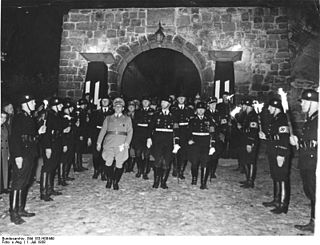
The Allgemeine SS was a major branch of the Schutzstaffel (SS) paramilitary forces of Nazi Germany; it was managed by the SS Main Office (SS-Hauptamt). The Allgemeine SS was officially established in the autumn of 1934 to distinguish its members from the SS-Verfügungstruppe, which later became the Waffen-SS, and the SS-Totenkopfverbände, which were in charge of the Nazi concentration camps and extermination camps. SS formations committed many war crimes against civilians and allied servicemen.

The Ordnungspolizei, abbreviated Orpo, meaning "Order Police", were the uniformed police force in Nazi Germany from 1936 to 1945. The Orpo organisation was absorbed into the Nazi monopoly on power after regional police jurisdiction was removed in favour of the central Nazi government. The Orpo was controlled nominally by the Interior Ministry, but its executive functions rested with the leadership of the SS until the end of World War II. Owing to their green uniforms, Orpo were also referred to as Grüne Polizei. The force was first established as a centralised organisation uniting the municipal, city, and rural uniformed police that had been organised on a state-by-state basis.

Otto Lebrecht Eduard Daniel Meissner was head of the Office of the President of Germany from 1920 to 1945 during nearly the entire period of the Weimar Republic under Friedrich Ebert and Paul von Hindenburg and, finally, under the Nazi government under Adolf Hitler.

Werner Lorenz was an SS functionary during the Nazi era. He was head of the Volksdeutsche Mittelstelle (VOMI), an organization charged with resettling ethnic Germans in the "German Reich" from other parts of Europe, as well as colonising the occupied lands during World War II. After the war, Lorenz was sentenced to prison for crimes against humanity in 1948. He was released in 1954 and died in 1974.
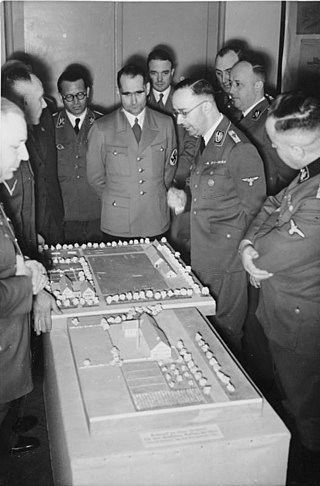
In Nazi Germany the Volksdeutsche Mittelstelle or VoMi was a Nazi Party agency founded to manage the interests of the Volksdeutsche - the population of ethnic Germans living outside the Third Reich. Ultimately coming under Allgemeine-SS administration, it became responsible for orchestrating the implementation of Nazi Lebensraum policies in Eastern Europe during World War II.
There was widespread support for animal welfare in Nazi Germany among the country's leadership. Adolf Hitler and his top officials took a variety of measures to ensure animals were protected.

The National Socialist League of the Reich for Physical Exercise was the umbrella organization for sports and physical education in Nazi Germany. The NSRL was known as the German League of the Reich for Physical Exercise until 1938. The organization was expanded to Austria after that country's annexation by Nazi Germany.

Amt Rosenberg was an official body for cultural policy and surveillance within the Nazi party, headed by Alfred Rosenberg. It was established in 1934 under the name of Dienststelle Rosenberg, with offices at Margarethenstraße 17 in Berlin, to the west of Potsdamer Platz. Due to the long official name of Rosenberg's function, Beauftragter des Führers für die gesamte geistige und weltanschauliche Erziehung der NSDAP, the short description Reichsüberwachungsamt "Reich surveillance office" was used alongside, also shortened simply to Überwachungsamt "surveillance office".

Friedrich Alpers was a German Nazi politician, a Luftwaffe officer and an SS-Obergruppenführer. He was also a Minister of the Free State of Brunswick, and Generalforstmeister in the government of Nazi Germany. Alpers was responsible for numerous political crimes in Brunswick. He died during the Second World War, most likely by suicide.
Child Euthanasia was the name given to the organized killing of severely mentally and physically disabled children and young people up to 16 years old during the Nazi era in over 30 so-called special children's wards. At least 5,000 children were victims of the program, which was a precursor to the subsequent murder of children in the concentration camps.
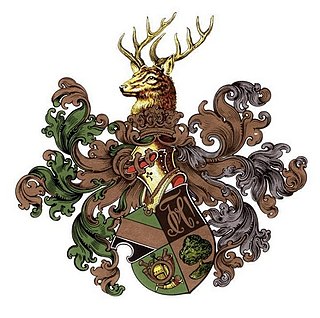
The Corps Hubertia Freiburg is a fraternity (Studentenverbindung) in Freiburg, Germany. It was founded on October 29, 1868, and is one of 162 German Student Corps in Europe today. The Corps is a member of the Kösener Senioren-Convents-Verband (KSCV), the oldest federation of classical European fraternities with roots dating back to the 15th century and member fraternities across Austria, Belgium, Germany, Hungary, Latvia and Switzerland.

Walter von Keudell was a German forest expert and politician. He served as interior minister of Germany between 1927 and 1928 during the period of the Weimar Republic.
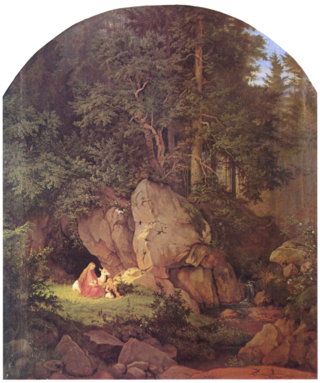
The German Forest was a phrase used both as a metaphor as well as to describe in exaggerated terms an idyllic landscape in German poems, fairy tales and legends of the early 19th-century Romantic period. Historical and cultural discourses declared it as the symbol of Germanic-German art and culture, or as in the case of Heinrich Heine or Madame de Staël, as a counter-image of French urbanity. It was also used with reference to historical or legendary events in German forests, such as Tacitus' description of the Battle of the Teutoburg Forest or even the nature mysticism of the stylized Germanic national myth, the Nibelungenlied as the history of its multi-faceted reception shows.

Chief of Civil Administration was an office introduced in Nazi Germany, operational during World War II. Its task was to administer civil issues according to occupation law, with the primary purpose being the support of the military command in the operational areas of the German Army. CdZ would pass his authority to a corresponding civil government after the territory in question became in the rear of the operating armed forces.

The Reich Ministry of Food and Agriculture was responsible for the agricultural policy of Germany during the Weimar Republic from 1919 to 1933 and during the Nazi dictatorship of the Third Reich from 1933 to 1945. It was headed by a Reichsminister under whom a state secretary served. On 1 January 1935, the ministry merged with the Prussian Ministry of Agriculture, Domains and Forests, founded in 1879. Until 1938 and the Anschluss with Austria, it was called the "Reich and Prussian Ministry of Food and Agriculture". After the end of National Socialism in 1945 and of the Allied occupation of Germany, the Federal Ministry of Food and Agriculture was established in 1949 as a successor in the Federal Republic of Germany.
Giselher Wirsing was a right-wing German journalist, author, and foreign policy expert who was active during Nazi Germany and the Bonn republic. He was a member of the Nazi party and contributed heavily to the creation and propagation of Nazi propaganda outside Germany.















